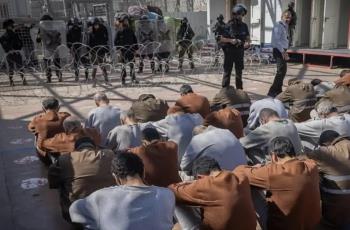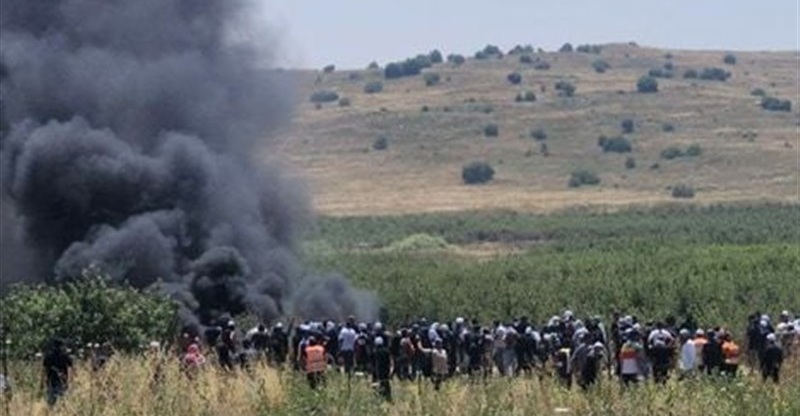Alwaght- The project of opening various fronts and tightening the noose on the Israeli regime that was a dream of Iran's General Qassem Soleimani these days is coming true at all levels with all coherent methods of the resistance. Along with intensification of the anti-Israeli operations by the resistance groups in the West Bank, people of the occupied Golan Heights have in recent days adopted confrontational policy against Tel Aviv. On Tuesday, clashes erupted between Druze of Golan and the Israeli army, and it seems that they keeps unfolding day by day.
The developments started when the military planned to install wind turbines in the northern areas of Golan, but thousands of Druze in this area objected to the plan, leading to clashes between the two sides. According to reports, 12 members of the Israeli police forces were injured, and more than 50 demonstrators were also injured or suffered suffocation due to tear gas and toxic bombs.
Occupied Golan residents gathered in front of the police headquarters on Wednesday and tried to seize the building, but the occupation forces dispersed them away.
The Israeli military deployed a large number of suppression forces to surround the agricultural lands in Al-Hafair area to seize the lands and prevent farmers from accessing their lands. They closed the roads leading to the lands to block people from reaching the wind farm.
The wind farm project is strongly opposed to by the people of Golan as they argue it will negatively impact their farms due to the high noise of the propellers and generators and the resultant damage to the environment.
The tensions run so high that the Israeli Prime Minister Benjamin Netanyahu met Sheikh Muwafaq Tarif, the spiritual leader of the Druze in the occupied Palestine. The outcome was a ceasefire agreement continuing to beyond the Eid Al Adha, on the condition that the project is halted in return for stopping the protests.
The new Israeli provocation in the occupied Golan comes as the government approved the project to install 25 wind turbines to produce electricity in Golan after the approval of the Planning Committee of the interior ministry. According to this plan, the government is going to implement this project in an area of 3,674 hectares of agricultural land in the villages of Majdal Shams, Masada, Bagatha and one and a half kilometers from the village of Ain Qanieh. Before this, the Israeli government planned to deceptively lease farmers' lands for 25 years for the project, but Golan residents opposed the plan.
The Golan Heights are part of Qunaitra province of Syria that were occupied in 1967 war and annexed in 1982. The international community has never recognized this action and even the UN General Assembly last year approved a resolution calling for the return of this region to Syria.
The Golan Heights has a population of about 50,000 people, more than half of whom are Jewish, and also home to Arab Druze, many of whom consider themselves Syrian and refuse to receive Israeli citizenship.
The Israeli authorities have always stressed that even if the international community's view against the Syrian government changes, it will not affect the situation in Golan and this region will forever remain part of the occupied territories, but it seems that after more than five decades, the policies of the Israelis have failed to align local residents with Tel Aviv's policies.
The anti-Israeli actions of the Druze have made Syria and the resistance groups even more resolved to retake the occupied Golan Heights. Syrian foreign ministry issued a statement condemning the brutal attacks of the Israeli military on the people of the occupied Golan and considered it an extension of the aggressive policies of the Israeli regime and emphasized that Golan has been and will remain an inseparable part of the Syrian territory and its return to the homeland is inevitable. Hamas and some Lebanese groups have also condemned the Israeli crimes in the occupied Golan and appreciated the people of this region's stand against the occupation and said that they stand by them.
Economic significance of Golan for Israelis
The occupied Golan is of high economic significance for the Israelis. Due to its high altitude and high rainfall, Golan provides about one-third of the water of the Jordan River, and together with Lake Tiberias, it is considered as one of the important sources of water supply for the occupied territories. Golan is the only place in the region that has cold weather and snow in most months of the year and the only ski resort in the four surrounding countries is located in Golan.
According to the statistics published by the Israeli regime, 21 percent of the production of kerma, a substance used in nuclear engineering and medicine, 40 percent of beef, and most importantly half of the fresh mineral water are provided by Golan.
The water crisis in the mid-1960s is said to have been one of the main causes of the Israeli-Syrian conflict that led to the June 1967 war, in which Damascus accused Tel Aviv of diverting the origins of the Jordan River for its own benefit. The Golan Heights has many natural resources, as it is a fertile agricultural land where the Syrian Arabs are famous for growing apples, while Israel invests in the region in grape growing to produce a variety of wines.
As the whole region is suffering from decrease in the water resources, experts suggest that the future wars will be for water, and Golan is important for all neighboring countries. The Israelis try to have these resources for free as they know that in case of eruption of a crisis, no country will help them.
Significance of geopolitical and security position of Golan
Golan is of exceptional strategic importance to it holders, as its unique geography and high mountains allow it to overlook all the cities in the center and west of the occupied territories from Damascus. Also, it overlooks areas in Jordan and Lebanon, and whoever controls this area militarily can access anywhere in surrounding regions, even with the simplest of conventional weapons.
With 1,800 square kilometers of size, Golan is a strategic region because its high altitude allows it to overlook border areas of four countries and, thus, watch them for tens of kilometers. From Golan, Damascus is visible with naked eyes. This feature makes Golan important in terms of military and security. Since the establishment of the Israeli regime in 1948 until the occupation of this region in 1967, Syria carried out mortar attacks on the occupied territories from Golan and the region was important for the Arabs in terms of military position.
On the other hand, Golan acts as a buffer between the Israeli regime and Syria, and Tel Aviv seeks to prevent Iran and Lebanon's Hezbollah, which support Damascus, from opening a front and strengthening their presence in the region. To this end, in recent years, the Israeli air force has carried out several attacks on some positions of resistance groups in Syria. After the start of the Syrian crisis in 2011, the occupied Golan became very important for Tel Aviv, and hundreds of terrorists from this area were transferred to the occupied territories for treatment, and now that Syria has managed to relatively restore peace and stability in the country, the focus on Golan has increased. Tel Aviv authorities are worried that Golan, like the West Bank and Gaza, will become a new front against them, a concern causing the Israeli government to augment its controls and military and security equipment in this region.
The Israelis were well aware that if the Syrian government gets rid of the terrorists, it will especially focus on Golan. This obsession drove a call by Tel Aviv on the US to recognize Israeli sovereignty over this occupied region. Washington responded affirmatively, but the world community took no step to this end.
Golan has been a point of dispute between Syria and the Israeli regime for over five decades, and the Israelis argue it is an inseparable part of the occupied territories. They know that losing this strategic region means losing a vantage point over surrounding Arab countries, as well as rich water resources. Additionally, Tel Aviv’s hardline government adds Golan to a project of Judization of the whole occupied territories. However, since the Syrian government has abandoned policy of tolerance of the enemy, this occupied region will be pregnant with new developments in the future. These contentious moves in the occupied Golan, therefore, will bring about new tensions in the Golan Heights as they are grappling with other open fronts. This will certainly impact Tel Aviv leaders, shatter their calculations, and force them into actions playing into hands of the Resistance camp.



























